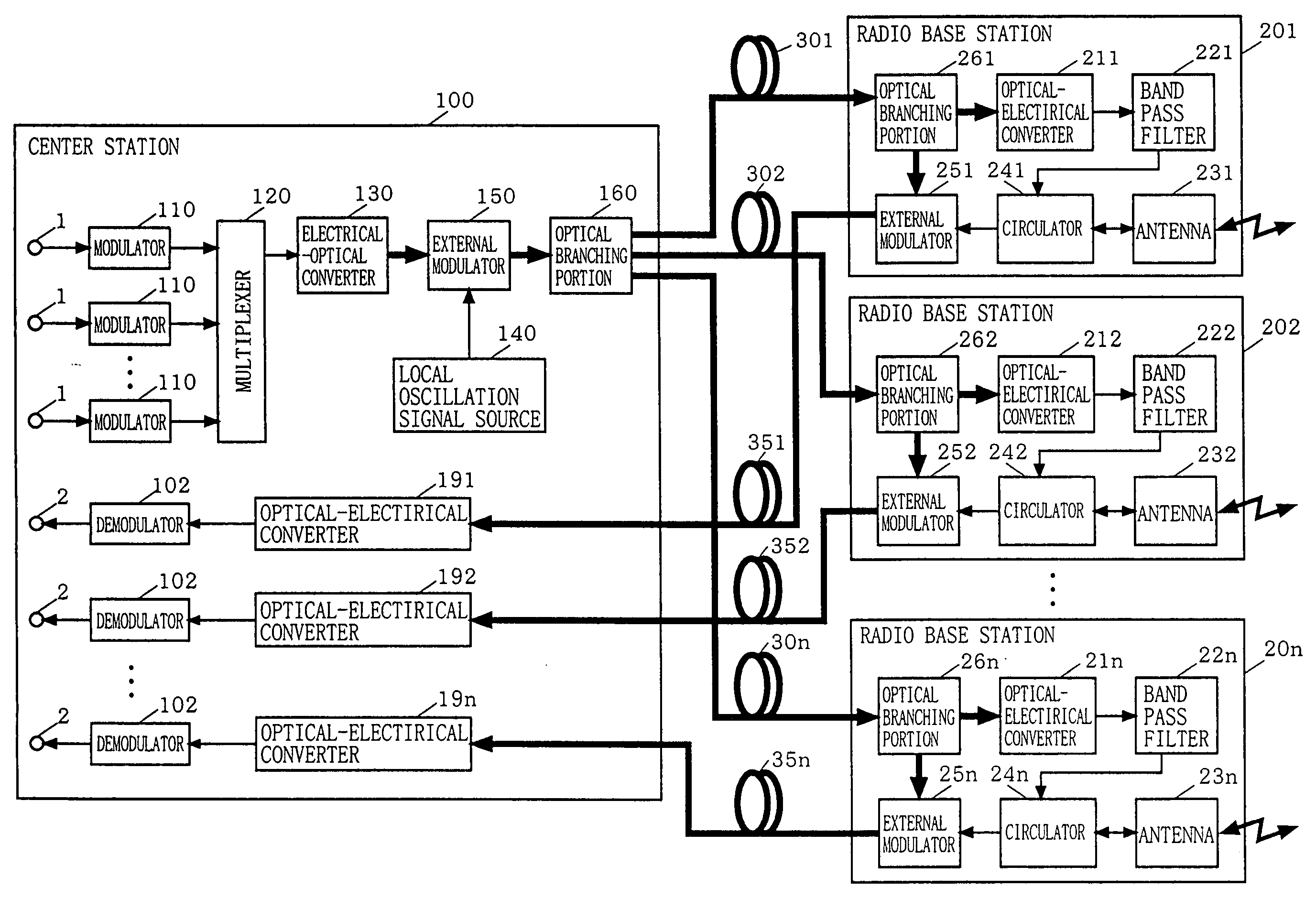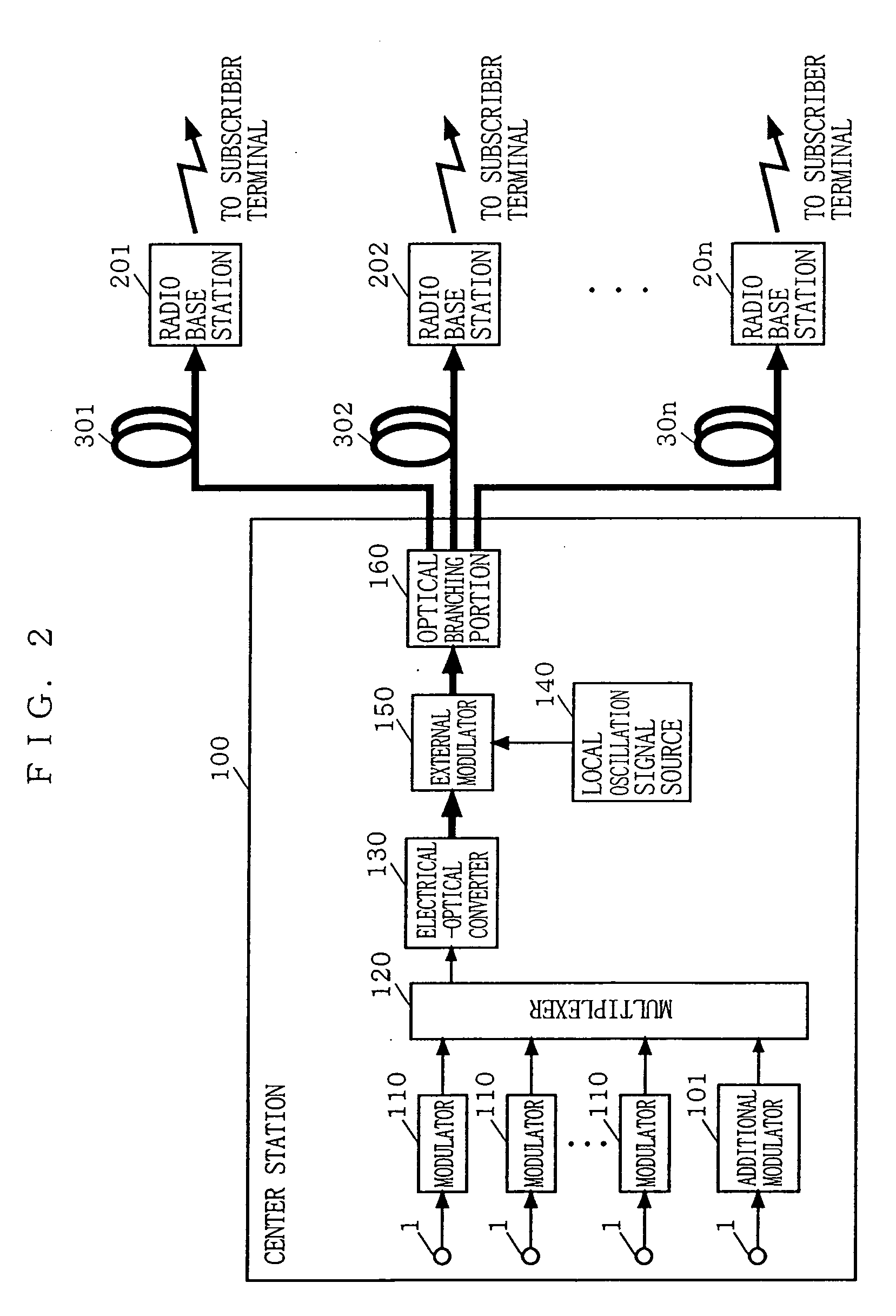Optical transmission system for radio access and high frequency optical transmitter
a transmission system and optical transmitter technology, applied in electromagnetic transmission, multiplex communication, electrical equipment, etc., can solve the problems of n expensive devices, high-frequency devices are generally expensive, and the level of electric signals is reduced, so as to avoid the distortion avoid the decrease of the level of the electric signal, and low cost
- Summary
- Abstract
- Description
- Claims
- Application Information
AI Technical Summary
Benefits of technology
Problems solved by technology
Method used
Image
Examples
first embodiment
[0168]FIG. 1 is a block diagram showing the configuration of an optical transmission system for radio access according to a first embodiment of the present invention. In FIG. 1, the optical transmission system according to the first embodiment is so constructed that a center station 100 and a plurality of radio base stations 201 to 20n are respectively connected to each other through a plurality of downstream optical fibers 301 to 30n.
[0169] The center station 100 includes a plurality of modulators 110, a multiplexer 120, an electrical-optical converter 130, a local oscillation signal source 140, an external modulator 150, and an optical branching portion 160. The radio base stations 201 to 20n respectively include optical-electrical converters 211 to 21n, band filters 221 to 22n, and antennas 231 to 23n. The operation of the optical transmission system according to the first embodiment will be described.
[0170] In the center station 100, different information to be transmitted to ...
second embodiment
[0182] In the optical transmission system according to the first embodiment, the plurality of IF signals are multiplexed by the frequency division multiplexing, and the IF signals frequency-division multiplexed are doubly intensity-modulated. In the radio base stations 201 to 20n, therefore, the band filters 221 to 22n must be respectively used to extract RF signal components having desired radio frequencies from the transmitted RF signals.
[0183] In the second embodiment, description is made of an optical transmission system which does not respectively require the band filters 221 to 22n in the configurations of radio base stations 201 to 20n.
[0184]FIG. 3 is a block diagram showing the configuration of an optical transmission system for radio access according to a second embodiment of the present invention. In FIG. 3, the optical transmission system according to the second embodiment is so constructed that a center station 100 and a plurality of radio base stations 201 to 20n are ...
third embodiment
[0189] The first and second embodiments were characterized by a case where information is transmitted from the center station to the subscriber terminal (in a downstream direction). Accordingly, description was made of the optical transmission system comprising the configuration for only downstream transmission.
[0190] In the third embodiment, description is then made of an optical transmission system in which an RF signal in an optical signal state obtained by frequency-converting an IF signal is utilized for a case where information is transmitted from a subscriber terminal to a center station 100 (in an upstream direction), to simplify a configuration required for upstream transmission.
[0191]FIG. 4 is a block diagram showing the configuration of an optical transmission system for radio access according to a third embodiment of the present invention. In FIG. 4, the optical transmission system according to the third embodiment is so constructed that a center station 100 and a plur...
PUM
 Login to View More
Login to View More Abstract
Description
Claims
Application Information
 Login to View More
Login to View More - R&D
- Intellectual Property
- Life Sciences
- Materials
- Tech Scout
- Unparalleled Data Quality
- Higher Quality Content
- 60% Fewer Hallucinations
Browse by: Latest US Patents, China's latest patents, Technical Efficacy Thesaurus, Application Domain, Technology Topic, Popular Technical Reports.
© 2025 PatSnap. All rights reserved.Legal|Privacy policy|Modern Slavery Act Transparency Statement|Sitemap|About US| Contact US: help@patsnap.com



